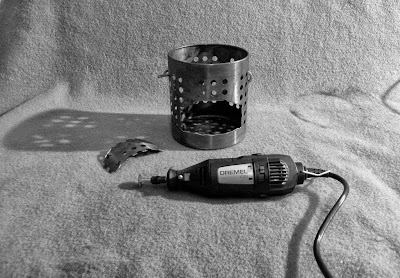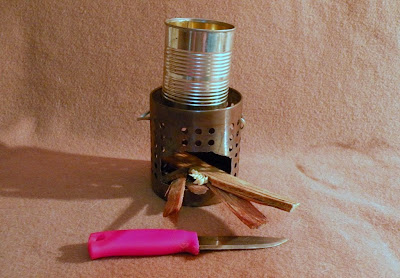While going for a walk in the woods, or a wander out in the bush - canoe camping, hiking or just plain picnicking - it is important to have with you some sort of stove. A campfire is ideal for when you are staying in place for a while, but a stove can be a quick, transportable, low-impact and temporary set up. Boiling water for food, for hygiene, for comfort and for a cup of tea is a important coping mechanism during a survival situation, and a worthwhile activity for when you are just plain out and about.

I read somewhere once that the first thing you should do if you are lost in the wilderness is to sit down and make a cup of tea. You see, making a cup of tea allows the survivor to engage in several useful and meaningful activities. To start with, sitting down prevents you from continuing to move through the woods without knowing where you are. This will increase the likelihood of being found. Next, gathering water is obviously important for survival, as is making a fire. But I think the most (non life-essential) aspect of making a cup of tea is that of focusing a lost survivor onto a simple, confidence-building set of tasks, and providing the comfort and relaxation that is needed in a crisis situation. Obviously without a tea bag, you can use anything from willow shoots to Ephedra to Spruce or pine needle tea.

I have used various fuels to power my stoves - most recently methyl hydrate (methyl alcohol), to white gas (naptha fuel), to propane, to wood. There are different reasons to use all of the fuels.

Propane: Reliable, but doesn't work well at sub-freezing temperatures. Very cold winter weather will cause the pressure within the heavy cylinders to drop, and result in a low gas output and subsequent low temperature flame. The upside to it is that for long camp stays, the cost is relatively low, so it is an economical fuel.

Naphtha: Great in cold temperatures, heat output is reliably constant. You don't have to worry about non-refillable containers as with propane. You do need specialized equipment to burn it, and you need to pump the cannister to maintain pressure. This isn't a big deal generally. It is quite smelly if it leaks in your knapsack though.

Methyl Alcohol: Universally available, it is easy to transport in a regular plastic bottle. You can burn it in a variety of stoves, some which can be made simply with a can of Coke. The flame isn't particularly hot, as compared to the other fuels however.

Wood: You can find this practically anywhere you camp. It is sooty and messy to burn, compared with the other refined fuels above. Not having to transport it is a plus.

Inspired by Wayland's wood hobo stove, by Pablo's Bushbuddy stove review, and by various forum threads, I decided to make my own hobo stove. Made primarily for wood, I can also place an alcohol stove in the container for a source of heat.

I started with a stainless steel cutlery drainer bought from IKEA for $4.00. Spring bought this for me. She knew it meant something to me at the time, but likely was not able to put her finger on exactly what it meant to me. Combined with a pair of steel tent stakes, bent slightly with pliers and trimmed short with tin-snips, I had the makings of my hobo stove.

Using a felt-tip pen, I drew a door on the stove where I would fuel it with small sticks, pine cones and organic matter. I used my new Dremel tool to cut out the door with a shower of sparks. I like my new Dremel tool.

The tent stakes are pushed through the top to act as a pot support. I put an empty can which can be used to boil water, or cook food into the stove. The stove itself fits nicely into my kettle, and the kettle slides nicely into my cooking pot.

All that remains is for me to cut the leg off of a pair of old pants, sew up on end, and run a cotton drawstring through holes around the top to make a bag that will keep the sooty pot from messing up my other gear while in transport.

And all you need to do after burning the wood is shake out the ashes once it has all cooled. I haven't used it yet, but expect to have a few test fires out in the backyard soon.

Cheers,
Mungo
I read somewhere once that the first thing you should do if you are lost in the wilderness is to sit down and make a cup of tea. You see, making a cup of tea allows the survivor to engage in several useful and meaningful activities. To start with, sitting down prevents you from continuing to move through the woods without knowing where you are. This will increase the likelihood of being found. Next, gathering water is obviously important for survival, as is making a fire. But I think the most (non life-essential) aspect of making a cup of tea is that of focusing a lost survivor onto a simple, confidence-building set of tasks, and providing the comfort and relaxation that is needed in a crisis situation. Obviously without a tea bag, you can use anything from willow shoots to Ephedra to Spruce or pine needle tea.

I have used various fuels to power my stoves - most recently methyl hydrate (methyl alcohol), to white gas (naptha fuel), to propane, to wood. There are different reasons to use all of the fuels.
Propane: Reliable, but doesn't work well at sub-freezing temperatures. Very cold winter weather will cause the pressure within the heavy cylinders to drop, and result in a low gas output and subsequent low temperature flame. The upside to it is that for long camp stays, the cost is relatively low, so it is an economical fuel.
Naphtha: Great in cold temperatures, heat output is reliably constant. You don't have to worry about non-refillable containers as with propane. You do need specialized equipment to burn it, and you need to pump the cannister to maintain pressure. This isn't a big deal generally. It is quite smelly if it leaks in your knapsack though.
Methyl Alcohol: Universally available, it is easy to transport in a regular plastic bottle. You can burn it in a variety of stoves, some which can be made simply with a can of Coke. The flame isn't particularly hot, as compared to the other fuels however.
Wood: You can find this practically anywhere you camp. It is sooty and messy to burn, compared with the other refined fuels above. Not having to transport it is a plus.
Inspired by Wayland's wood hobo stove, by Pablo's Bushbuddy stove review, and by various forum threads, I decided to make my own hobo stove. Made primarily for wood, I can also place an alcohol stove in the container for a source of heat.
I started with a stainless steel cutlery drainer bought from IKEA for $4.00. Spring bought this for me. She knew it meant something to me at the time, but likely was not able to put her finger on exactly what it meant to me. Combined with a pair of steel tent stakes, bent slightly with pliers and trimmed short with tin-snips, I had the makings of my hobo stove.
Using a felt-tip pen, I drew a door on the stove where I would fuel it with small sticks, pine cones and organic matter. I used my new Dremel tool to cut out the door with a shower of sparks. I like my new Dremel tool.
The tent stakes are pushed through the top to act as a pot support. I put an empty can which can be used to boil water, or cook food into the stove. The stove itself fits nicely into my kettle, and the kettle slides nicely into my cooking pot.
All that remains is for me to cut the leg off of a pair of old pants, sew up on end, and run a cotton drawstring through holes around the top to make a bag that will keep the sooty pot from messing up my other gear while in transport.
And all you need to do after burning the wood is shake out the ashes once it has all cooled. I haven't used it yet, but expect to have a few test fires out in the backyard soon.
Cheers,
Mungo

